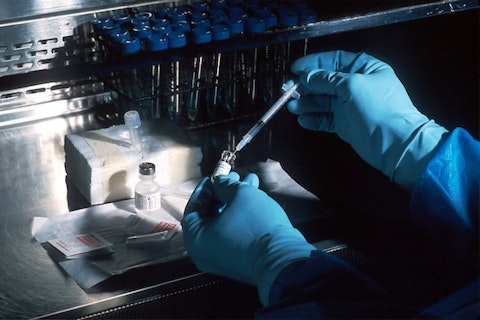Iovance Biotherapeutics, Inc. (NASDAQ:IOVA) Q4 2022 Earnings Call Transcript March 1, 2023
Operator: Welcome to the Iovance Biotherapeutics Fourth Quarter and Full Year 2022 Financial Results and Corporate Update Conference Call. My name is Gigi and I will be your operator for today’s call. Please note that this conference is being recorded. I will now turn the call over to Sara Pellegrino, Senior Vice President, Investor Relations and Corporate Communications at Iovance. Sara, you may begin.
Sara Pellegrino: Thank you, operator. Good afternoon and thank you for joining us. Speaking on today’s call, we have Dr. Fred Vogt, our Interim President and Chief Executive Officer; Dr. Igor Bilinsky, our Chief Operating Officer; Jim Ziegler, our Executive Vice President, Commercial; Dr. Friedrich Finckenstein, our Chief Medical Officer; and Jean-Marc Bellemin, our Chief Financial Officer. Dr. Raj Puri, our Executive Vice President, Regulatory Strategy and Translational Medicine, is also available for the Q&A session. This afternoon, we issued a press release that can be found on our corporate website at iovance.com, which includes the financial results for the 3 and 12 months ended on December 31 as well as recent corporate updates.
Before we start, I would like to remind everyone that statements made during this conference call will include forward-looking statements regarding Iovance’s goals, business focus, business plans and transactions, pre-commercial activities, clinical trials and results, regulatory interactions, plans and strategies, research and preclinical activities, potential future applications of our technologies, manufacturing capabilities, regulatory feedback and guidance, payer interactions, licenses and collaborations, cash position and expense guidance, and future updates. Forward-looking statements are subject to numerous risks and uncertainties, many of which are beyond our control, including the risks and uncertainties described from time-to-time in our SEC filings.
Our results may differ materially from those projected during today’s call. We undertake no obligation to publicly update any forward-looking statements. With that, I will turn the call over to Fred.
Fred Vogt: Thank you, Sarah and good afternoon everyone. I am pleased to highlight the positive milestones and significant progress at Iovance in 2022 and into the beginning of 2023. We are close to completing our biologics license application, or BLA, for our lead TIL therapy, lifileucel, in advanced melanoma before the end of this quarter. We are also preparing for commercialization, developing a robust immunooncology pipeline integrating Proleukin upon the close of our planned acquisition. The BLA for lifileucel remains our number one priority on behalf of patients with advanced melanoma who progress on or after anti-PD-1 therapy. This represents a significant unmet medical need given that there are currently no FDA approved treatment options in this setting.
We feel very confident going into the BLA review process given the strength of our clinical data and unmet need as well as several positive interactions with and feedback from the FDA during 2022. These included FDA alignment on the potency assay matrix last April and a successful pre-BLA meeting in July, where the FDA provided favorable feedback on the clinical efficacy data from Cohorts 2 and 4 of our C-144-01 clinical trial, including duration of follow-up and that the clinical and safety dataset was sufficient for a BLA review. In the fourth quarter, we also reached agreement with the FDA on our recently started TILVANCE-301 Phase 3 trial, frontline advanced melanoma to serve as a registrational triad indication as well as a confirmatory study supporting full approval of lifileucel in post anti-PD-1 advanced melanoma.
We expect TILVANCE-301 to be well underway at the time of potential approval and Frederick will talk about additional details to the trial on today’s call. Overall, the FDA continues to be engaged and supportive. We look forward to continuing this level of collaboration in 2023. We are also preparing to integrate Proleukin upon the close of our planned acquisition of this product. As a reminder, we announced last month that we have entered into a strategic transaction with Clinigen to acquire worldwide rights to Proleukin, an IL-2 product with currently approved indications it is importantly also used to promote T-cell activity following TIL infusions. We have a strong strategic fit and rationale for this transaction, which provides immediate and future revenue and full control of the IL-2 supply chain and logistics surrounding TIL therapy and is expected to lower clinical trial expenses and future cost of goods for lifileucel.
In addition to lifileucel on melanoma, we are building a deep and diverse TIL therapy pipeline in multiple solid tumor types that has the potential to create significant value for cancer patients as well as our shareholders. We are conducting 6 active clinical trials preparing to randomize patients in the frontline melanoma treatment setting and our first Phase 3 study in advancing several genetically modified TIL therapies, which Frederic will also highlight on today’s call. As we grow our organization to prepare for our first potential launch, we currently have more than 500 Iovance employees who have expertise in developing and commercializing oncology and cell and gene therapy products. I look forward to addressing your questions later during this call.
And we will now ask Igor to address our manufacturing updates and preparations to supply commercial TIL therapies upon potential approval.
Igor Bilinsky: Thank you, Fred. Manufacturing is critical for any commercial launch, particularly for autologous TIL therapies. So our top priority is to prepare for commercial supplies to meet patient needs, while continuing to scale up our internal capabilities and staffing. We are focused on operational excellence and maintaining consistent TIL manufacturing success rate of more than 90% in more than 600 patients treated with Iovance TIL therapy to-date. We are currently supplying clinical studies from iCTC, which is operating flex suites for clinical manufacturing and core suites for BLA readiness activities in preparation for commercial manufacturing. We have done significant work to ensure that iCTC and our contract manufacturers’ facility are well prepared for launch, with many of our current efforts focused on the FDA pre-approval inspections that we expect to occur during the BLA review process.
The iCTC is expected to supply most of the commercial TIL therapies upon approval with contract manufacturers to provide additional flexibility to optimally balance capacity and patient demand. Beyond our initial launch of lifileucel, we are planning for future capacity needs as we look to establish TIL as the next paradigm shifting class of cancer therapy. The iCTC is currently built as annual capacity to supply TIL products for more than 2,000 patients with available shelf space that we can build out to supply products for more than 5,000 patients annually from this facility. Longer term by adding new facilities as well as streamlining and automating manufacturing processes, our vision is to build capacity for more than 10,000 patients annually.
Our intellectual property, or IP, is also critical component to support and protect our proprietary manufacturing processes and know-how and to further solidify our global leadership in TIL therapy. We currently own at least 60 granted or allowed U.S. and international patents, including Gen 2 patent rights that are expected to provide exclusivity into 2038. Extensive detail on Iovance-owned IP is highlighted on our corporate website and within our annual report on Form 10-K. I would now like to hand the call to Jim Ziegler to highlight our commercial lunch preparations.
Jim Ziegler: Thank you, Igor. Throughout 2022, the commercial team made steady progress towards launch. With the ongoing PLA submission, our launch priorities include onboarding of our authorized treatment centers, or ATCs, secure an appropriate access and achieving operational readiness. Our cross-functional teams continue to partner with and onboard ATCs to develop new workflows that are unique to TIL therapy while leveraging workflows within existing cell therapy service lines at these centers. Our ATC operations and regional account director teams have structured interactions to support an efficient ATC onboarding process and we have developed the training curriculum to ensure multidisciplinary teams can administer the lifileucel treatment regimen upon FDA approval.
The timing and execution of key onboarding activities and training at each center are aligned to our regulatory timelines. We support each center in developing their TIL service line and we plan just-in-time training to ensure launch readiness. Our reimbursement strategies are focused on securing coding, coverage and payment. Our market access team continues to engage the key national and regional payers. As we transition from the clinical trial to commercially approved setting, our goal is to ensure patients have appropriate and timely access to lifileucel. Our cross-functional team is also assessing our needs and capabilities and developing our implementation plan for Proleukin. We are also fortunate to have several cross-functional team members with prior Proleukin leadership experience who are leading and developing our end-to-end integration processes.

Photo by National Cancer Institute on Unsplash
We are preparing for a smooth transfer and operational readiness for Proleukin upon the close of our planned acquisition. We understand that launching an autologous cell therapy requires sustained operational excellence. And I want to acknowledge the critical thinking, problem-solving and tireless efforts of our cross-functional team. Our team has set a high bar for themselves to ensure the highest quality of operational excellence. We are well-positioned to scale our efforts to ensure commercial launch readiness. I will now pass the call to Friedrich Frankenstein, our Chief Medical Officer to highlight our clinical progress.
Friedrich Finckenstein: Thank you, Jim. Today, I would like to summarize our TIL therapy pipeline and next generation technology. I will begin with our multi-pronged strategy in advanced melanoma. Our ongoing rolling DNA submission for lifileucel in post anti-PD-1 advanced melanoma is based on the results from our C-144-01 trial, the largest single clinical study ever conducted for TIL therapy in post ICI melanoma. In the fourth quarter, we presented positive data from C-144-01 Cohorts 2 and 4 to the medical community for the first time at the Society for Immunotherapy of Cancer for SITC Annual Meeting last November and published results from the study in the Journal of Immunotherapy of Cancer or JITC in December. We are confident that the strength of the clinical data from 153 patients and the C-144-01 trial, including our pivotal Cohort 4 in support of Cohort 2 support approval.
Following the recent posting of our Phase 3 TILVANCE-301 trial in frontline advanced melanoma on clinicaltrials.gov, I would like to highlight additional detail on this trial to-date. We reached agreement with the FDA for TILVANCE-301 to serve as our registrational trials like and full approval of lifileucel n combination with pembrolizumab in frontline advanced melanoma as well as a confirmatory trial to support full approval of lifileucel in post-anti-PD-1 advanced melanoma. Notably, we were very pleased that the FDA agreed to dual primary endpoint of blinded independent review committee or BIRC assess objective response rate or ORR and progression-free survival or PFS. TILVANCE-301 also includes several secondary endpoints such as overall survival and duration of response.
In terms of trial design, we plan to randomize 670 patients who are naïve to therapy in the advanced setting, equally to either lifileucel in combination of pembrolizumab and the experimental arm of pembrolizumab monotherapy and the control arm. We are including an appropriate number of global sites such as many large U.S. and European cancer centers and in numerous other countries, where we expect from enrollment. In the control arm, patients will have the option to receive TIL monotherapy upon confirmed disease progression verified by the IRC. Additional information on trial design, outcome measures and eligibility criteria are available on clinicaltrials.gov. Our confidence in the success of TILVANCE-301 is based on results from Cohort 1a in our IOV-COM-202 trial of lifileucel in combination with pembrolizumab in ICI-naïve advanced melanoma, in addition to prior data at the NCI for TIL monotherapy in anti-PD-1 naïve melanoma generated in the pre-ICI era.
We look forward to advancing our frontline melanoma strategy through our 2023 ensuring site activation and patient randomization in TILVANCE-301. As Fred mentioned, TILVANCE-301 is expected to be well underway at the time of potential BLA approval for lifileucel in post anti-PD-1 advanced melanoma. We continue to execute on our non-small-cell lung cancer or NSCLC pipeline at Iovance, with 6 cohorts across 3 Iovance studies to investigate multiple treatment regimens in various populations at various stages of disease. We recently shared top line initial data from Cohort 3A of the IOV-COM-202 trial, which we highlighted in the press release and investor conference call last month. Based on initial Cohort 3A positive results in patients with advanced NSCLC who are naive to ICI treatment, particularly within the treatment-naive and post-chemotherapy success, we plan to meet with FDA in 2023 to discuss data and the potential registration path for lifileucel in frontline advanced NSCLC patients.
Enrollment to Cohort 3A is ongoing and we plan to present detailed and updated results at a medical meeting this year. Our IOV-LUN-202 trial is investigating LN-145 monotherapy in patients who have received prior anti-PD1 and chemotherapy. In combination or sequentially and includes an option for pre-progression tumor harvest. We enrolled patients for 2022 and expect to continue enrollment this year. Moving to cervical cancer, enrollment is underway in our expanded Cohort 2 in the ongoing C-145-04 trials in patients who have progressed after chemotherapy and anti-PD1 therapy. As a reminder, Cohort 2 is intended to be pivotal to support regulatory submissions following dialogue and feedback from the FDA. And we look forward to continuing Cohort 2 enrollment during the year.
We are excited about our next generation TIL therapy. We are developing several genetically modified TIL therapies that utilize the gene-editing TALEN technology licensed from selected to optimize TIL therapy by inactivating immune checkpoint proteins that inhibit anti-tumor response. IOV-4001 is our first genetically modified PD1 inactivated TIL therapy candidate. In the third quarter of last year, we treated the first patient with IOV-4001 in our first-in-human IOV-GM1-201 trial in patients with previously treated advanced melanoma or NSCLC. Additional programs using the TALEN technology are expected to enter clinical development in 2024, including genetically modified TIL therapy with multiple inactivated immune checkpoint targets. Earlier stage research and preclinical studies include additional approaches to increase TIL potency, including the selection of CD39/69 double negative TIL and enhancements, such as tethered cytokine.
As part of our strategy to optimize the TIL treatment regimen, we also continue IND-enabling studies of our novel interleukin analog IOV-3001. I am available during the question-answer-session. For now, I will hand the call over to Jean-Marc to discuss our fourth quarter and full year 2022 financial results.
Jean-Marc Bellemin: Thank you, Friedrich. My comments will summarize our planned acquisition of Proleukin as well as the high level financial results from our fourth quarter and full year ended on December 31, 2022. More details can be found in this afternoon’s press release as well as in your SEC filings. Last month, we announced that we have entered into an agreement to acquire Proleukin from Clinigen. Terms of the agreement include an upfront payment of £167.7 million, the £49.7 million milestone payment upon first approval of lifileucel in advanced melanoma and double-digit Proleukin global sales royalties from Iovance to Clinigen. The transaction will be financed with existing cash and is expected to close after all conditions are met, including regulatory approvals and clearance and other customary closing conditions.
As the late stage oncology company approaching potential commercialization this year, we are also investing in launch preparations, return on manufacturing and pipeline activities. As of December 31, 2022, we held $478.3 million in cash, cash equivalents, investments and restricted cash compared to $602.1 million on December 31, 2021, taking into account proceeds raised in 2023 from our other market or ATM facility, our unaudited cash position is approximately $670 million as of February 24, 2023, which includes approximately $460 million in net proceeds raised through the ATM during the fourth quarter of €˜22 and into the first quarter of €˜23. The current and strengthened cash position is expected to fund our operating plan into the second half of 2024 including the Proleukin acquisition, manufacturing activities, launch readiness and execution, planned clinical trials and pipeline advancements.
Transitioning to the financial results for the fourth quarter and full year ended December 31, 2022, our net loss for the fourth quarter 2022 was $105.3 million or $0.64 per share compared to net loss of $99.3 million or $0.63 per share for the fourth quarter of 2021. Net loss for the full year of 2022 was $395.9 million or $2.49 per share compared to net loss of $342.3 million or $2.23 per share for the full year 2021. Research and development expenses were at $80.6 million for the fourth quarter 2022, an increase of $5 million compared to $75.6 million for the fourth quarter of 2021. Research and development expenses were $294.8 million for the full year 2022, an increase of $35.8 million compared to $259.0 million for the full year 2021.
The increase in research and development expenses in the fourth quarter and full year 2022 over the prior year periods were primarily attributable to cost associated with the growth of the internal research and development team, including stock-based compensation expense as well as facility related expenses and internal research programs. These increased expenses were partially offset by lower clinical and manufacturing costs driven by completion of enrollments in clinical costs of our clinical trials. General and administrative expenses were $26.5 million for the fourth quarter of 2022, an increase of $2.7 million compared to $23.8 million for the fourth quarter 2021. General and administrative expenses were $104.1 million for the full year 2022, an increase of $20.4 million compared to $83.7 million for full year 2021.
The increase in general and administrative expenses in the fourth quarter and full year 2022 compared to the prior year periods were primarily attributable to cost associated with the growth of the internal general and administrative and promotional teams, including stock-based compensation expense, the build-out of the new corporate headquarter as well as pre-commercial activities. As of December 31, 2022, there were approximately 187.8 million common shares outstanding. I will now hand the call back to the operator to kick off the Q&A session.
See also 15 Most Profitable Penny Stocks and 11 Most Promising Cancer Stocks.
Q&A Session
Follow Iovance Biotherapeutics Inc. (NASDAQ:IOVA)
Follow Iovance Biotherapeutics Inc. (NASDAQ:IOVA)
Operator: Thank you. Our first question comes from the line of Peter Lawson from Barclays.
Peter Lawson: Great. Thanks so much for taking the questions. Fred, you said it confident around the BLA submission by the end of 1Q kind of what needs to be done there, what’s left?
Fred Vogt: Yes, Peter, we are really confident that we are going to get this done. We have essentially a lot of activities we talk about relating to the assay work, CMC work, validation work and stuff like that, that we are completing. We have talked about it before. It’s relatively routine work. But it’s very important to the FDA and that’s kind of what we are getting done here. So we can complete the rolling BLA submission.
Peter Lawson: Okay, okay. And then I know sometimes off, but just on the launch, lifileucel, are you expecting to see a bolus of patients on launch and kind of any way you can kind of quantify that?
Fred Vogt: Yes, Jim, do you want to take that one?
Jim Ziegler: Sure. Given our experience in dialoguing with the KOLs at many of these sites in our €“ even our clinical trial experience, there is a high unmet need and this translates into a number of patients who are in need of therapy after checkpoint inhibitor. So we are expecting a bolus of patients at launch given that high unmet need.
Fred Vogt: And Peter, we do run an EAP program in order to stay in close contact with the site so that we are making sure that we have a good feel for what’s out there, adding care for patients as FDA wants you to do.
Peter Lawson: Thank you.
Operator: Thank you. Our next question comes from the line of Mark Breidenbach from Oppenheimer.
Mark Breidenbach: Hey, guys. Thanks for taking the question. Two quick ones for me. First, I am wondering if you can just comment on remaining barriers before you can begin recruitment into the TILVANCE-301 study? And then I am also wondering, aside from the Cohort 3A lung data, that Friedrich mentioned, are there plans for additional clinical data presentations in 2023? Thanks for taking the questions.
Fred Vogt: Friedrich, do you want to talk a little bit about the startup activities for 301 and you could probably talk about a little bit about the potential for lung data later this year too, if you want?
Friedrich Finckenstein: Sure. Happy to. Thanks for the question. So we have spoken about being in startup on TILVANCE-301. So that basically means submission of the protocol to sites, reviews at sites, like startup site initiation and then startup enrollment, there are no specific additional hurdles. That would be kind of one hurdle that would apply to all sites, it’s now really activities at individual sites. And much of that work is basically going on in parallel and will continue as we are adding a meaningful number of sites both in the U.S. as well as ex-U.S., Europe and beyond Europe to the sites that will enroll to this trial. So really, non-specific hurdle to site startup activities at individual sites. Does that make sense?
Mark Breidenbach: Sure. I guess I am trying to get a sense for when you would expect the first patient to be enrolled?
Friedrich Finckenstein: Yes, we haven’t guided to when exactly the first patient will be enrolled. What we have said though is that we expect enrollment to be well underway at the time of approval of the relapsed refractory indication. And I think that’s the main point here.
Fred Vogt: Yes, Mark, we would certainly advise everyone if when we do randomize the first patient.
Mark Breidenbach: Got it. And then with respect to other clinical presentations besides the Cohort 3A lung data?





